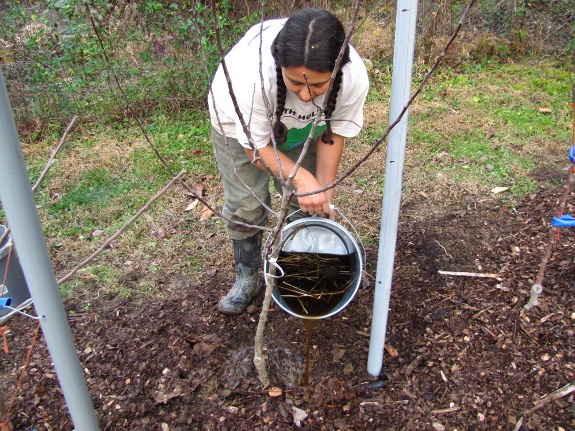
Maintaining small trees on non-dwarfing rootstocks

Although Mark and I are
excited about the possibilities of a high-density
apple planting,
we're also well aware of all of the disadvantages of dwarfing
rootstocks. So we're hedging our bets with three apples on M111, trained using similar methods to
those on Bud9.
In case you're not a
rootstock geek, M111 is a rootstock that makes a
semi-dwarf tree, generally reaching a spread of 14 to 20 feet, compared
to 6 to 10 feet for Bud9. I've had at least two apple growers
tell me that they manage to keep semi-dwarf trees down to the size of a
dwarf with careful pruning and training, giving them the benefits of a
more copious root system without requiring the space of a typical
semi-dwarf tree. I hope I can do the same and can include early
bearing in the list of dwarf-like properties of a miniaturized
semi-dwarf.
 Reality hit when the
semi-dwarf trees showed up and required a lot more initial pruning than
the dwarf trees did. The latter had been trained in the nursery
with a high density system in mind, so they had lots of little branches
("feathers") running up and down the trunk, but the former simply had
two whorls of scaffolds a couple of feet apart. I kept the bottom
whorl (although shortening and training the branches down below
horizontal), then whacked off the top to promote new branching along
the trunk.
Reality hit when the
semi-dwarf trees showed up and required a lot more initial pruning than
the dwarf trees did. The latter had been trained in the nursery
with a high density system in mind, so they had lots of little branches
("feathers") running up and down the trunk, but the former simply had
two whorls of scaffolds a couple of feet apart. I kept the bottom
whorl (although shortening and training the branches down below
horizontal), then whacked off the top to promote new branching along
the trunk.
To keep this
semi-scientific, I sprinkled the semi-dwarfs amid the dwarfs and was
careful to include one variety that was duplicated on the two types of
rootstock. The experiment obviously won't give me scientific data
good enough to print, but should help me decipher which system works
best on our farm. I'm excited to start playing with training in
earnest once the spring growing season begins!
Want more in-depth information? Browse through our books.
Or explore more posts by date or by subject.
About us: Anna Hess and Mark Hamilton spent over a decade living self-sufficiently in the mountains of Virginia before moving north to start over from scratch in the foothills of Ohio. They've experimented with permaculture, no-till gardening, trailersteading, home-based microbusinesses and much more, writing about their adventures in both blogs and books.
Want to be notified when new comments are posted on this page? Click on the RSS button after you add a comment to subscribe to the comment feed, or simply check the box beside "email replies to me" while writing your comment.

Good job on removing the second scaffold whorl! I think I saw this tree in earlier pictures and there was no defined central leader. Looks much better now!
If you focus on the dominant central leader and tie down the scaffolds you'll be off to a great start. Once the scaffolds get to big you can renewal prune with a bevel cut.
Good Luck!